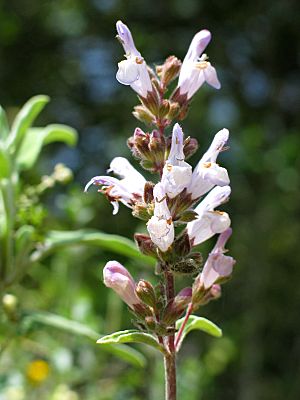Greek sage facts for kids
Quick facts for kids Greek sage |
|
|---|---|
 |
|
| Scientific classification | |
| Genus: |
Salvia
|
| Species: |
fruticosa
|
| Synonyms | |
|
Salvia libanotica Boiss. & Gaill. |
|
Salvia fruticosa, or Greek sage, is a plant that grows back every year. It is a type of herb or small shrub. You can find it naturally in the eastern Mediterranean area. This includes places like Southern Italy, the Canary Islands, and North Africa. It grows a lot in Palestine, Israel, and Lebanon.
What Greek Sage Looks Like
Greek sage plants usually grow about 2 feet (0.6 meters) tall and wide. Their flower stalks can reach 1 foot (0.3 meters) or more above the leaves. The whole plant is covered in tiny hairs. It has many leaves of different sizes that grow in groups. This makes the plant look silvery and bushy.
The flowers are a pretty pinkish-lavender color. They are about 0.5 inches (1.3 cm) long. These flowers grow in circles along the stem. They are held in a small, reddish-brown, five-pointed cup called a calyx, which is also hairy. In its natural home, Greek sage often grows in Maquis shrubland. It can also be found in other open plant areas. Sometimes, you can even find whole fields of only Salvia fruticosa plants.
People also grow Greek sage as a beautiful flowering shrub in their gardens. It likes lots of sunshine and soil that drains water well. It also needs good air flow. This plant can handle cold weather down to about 20 degrees Fahrenheit (-6 degrees Celsius). It is very good at surviving dry periods without much water. The leaves have a lot of oil in them. This oil contains some of the same chemicals found in lavender.
How Greek Sage is Classified
Over the years, there has been some confusion about how to name Salvia fruticosa. This is because its leaves can look very different. Many times, these different leaf shapes were thought to be separate types of plants. For example, S. libanotica, S. triloba, S. lobryana, and S. cypria were once thought to be different species. But now, scientists know they are all just variations of Salvia fruticosa.
The way the leaves look can depend on where the plant grows. For instance, plants on the western side of Crete have smooth, flat, dark green leaves. But plants on the eastern side of the island have much smaller leaves. These leaves are often yellowish-green and have three deep lobes with wavy edges. These differences in leaf shape continue across different parts of Greece.
Adding to the naming confusion, the plant was also called Salvia triloba. This name was given by Carl Linnaeus the Younger in 1781. However, it was later found to be the same plant that Philip Miller had named in 1768. When two names exist for the same plant, the older name is usually chosen. This is a rule in plant naming. Some local names for this plant include sage apple, Khokh barri, and Na’ama Hobeiq’es-sedr.
Uses of Greek Sage
Greek sage has been used for a very long time in Greece. People value it for its beauty, its use in medicine, and for cooking. It also provides sweet nectar and pollen for bees. A painting of Salvia fruticosa was found in a Minoan artwork from around 1400 BCE. This painting was found at Knossos on the island of Crete. It is thought that ancient Phoenicians and Greeks brought the plant to Spain and Portugal for growing. You can still find some of these introduced plants in coastal areas today.
Greek sage makes up a large part (50–95%) of the dried sage sold in North America. It is grown on farms to get its essential oil. It also has a long history of use in different Muslim traditions. It is used for newborn children, at weddings, in funerals, and burned as incense. There is also a special plant called "silver leaf sage" or "Salvia Newe Ya'ar'". This plant is a mix between S. fruticosa and Salvia officinalis. It was developed in the Middle East and is used in cooking.
In its natural home, Greek sage often grows fuzzy bumps called 'apples'. These 'apples' are about 1 inch (2.5 cm) wide. People peel and eat them when they are soft. They are said to be fragrant, juicy, and tasty. At first, people thought these 'apples' only grew on a different plant called Salvia pomifera. This led to many Salvia fruticosa plants with 'apples' being wrongly identified. But in 2001, scientists found out that the 'apples' on Salvia fruticosa were caused by a tiny insect. This insect was a type of gall wasp that had never been discovered before.
See also
 In Spanish: Salvia de jardín para niños
In Spanish: Salvia de jardín para niños

